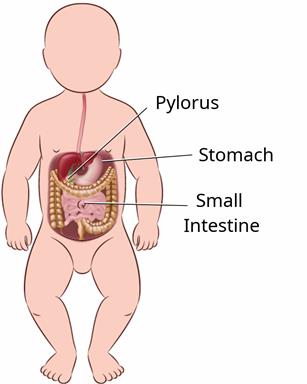Narrowing of the Opening Between the Stomach and Small Intestine (Pyloric Stenosis) in Infants: What to Know

Pyloric stenosis happens when the opening between the stomach and the small intestine gets too small. This opening is called the pylorus. Food moves from the stomach, through the pylorus, and into the small intestine.
In babies with pyloric stenosis, the small opening can start to block food from leaving the stomach. Over time, it gets worse and can get fully blocked.
Pyloric stenosis often develops in the first few weeks after birth, usually between 2–12 weeks of age.
What are the causes?
The cause of pyloric stenosis is not known.
What increases the risk?
The risk of pyloric stenosis may be greater if your baby is:- Male.
- Bottle fed.
- Born too early (premature).
- Your baby was given certain antibiotics shortly after birth.
- Your baby was exposed to tobacco during pregnancy.
- Your baby was born by C-section.
- Someone in your family has had pyloric stenosis.
What are the signs or symptoms?
The main symptom of pyloric stenosis is very forceful (projectile) throwing up in the first weeks of life. Often there are no other signs of illness and your baby may not look sick.
You may see these signs:- Constant hunger, even after throwing up.
- Rippling of belly muscles.
- An olive-sized lump that can be felt in the middle of the belly.
- Lack of weight gain.
- Dry skin, dry mouth, or dry diapers.
- Little or no tears.
- Sleeping more than usual or being hard to wake up.
How is this diagnosed?
Pyloric stenosis is diagnosed based on:- Your baby's symptoms.
- A physical exam and medical history.
- Ultrasound of the belly.
- Blood tests.
- X-rays.
How is this treated?
Surgery is needed to treat this condition. During surgery, the muscle around the pylorus is cut. This opens the passage from the stomach to the small intestine.
If your baby has been throwing up often, they may need extra care and fluids before surgery. This may include:- Giving your baby fluids through an IV, often placed in an arm or hand.
- Placing a tube that goes from the nose or mouth into the stomach. This may help with throwing up.
This information is not intended to replace advice given to you by your health care provider. Make sure you discuss any questions you have with your health care provider.

